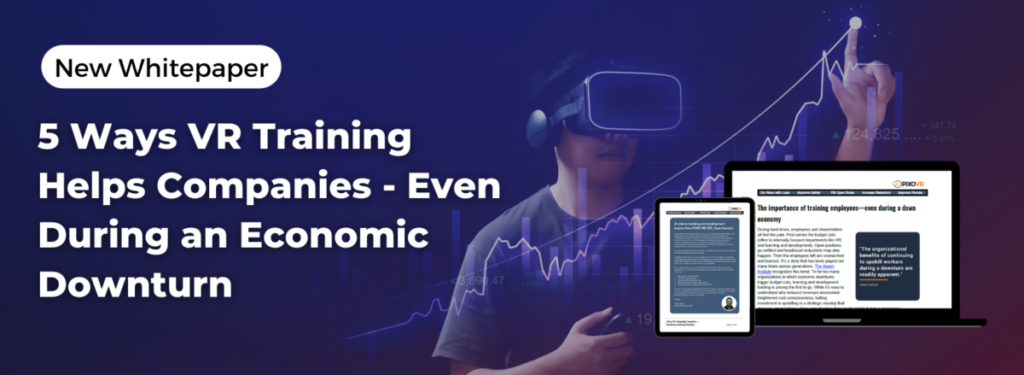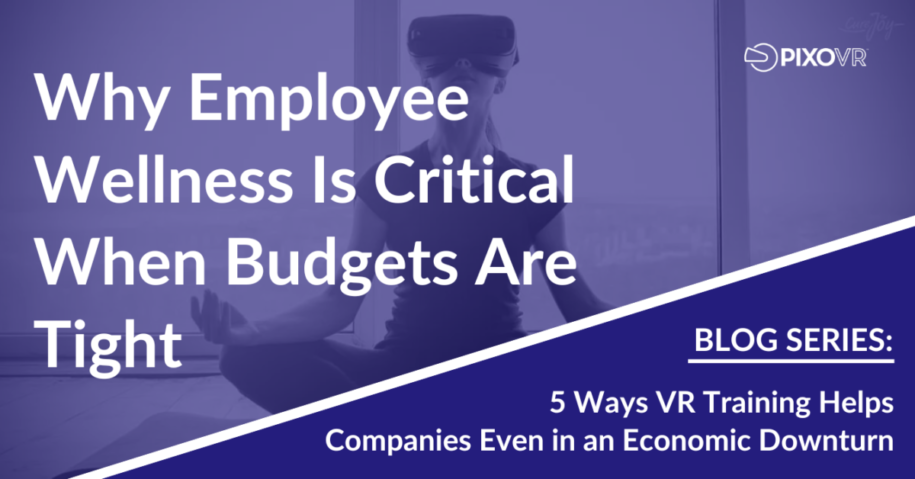The following is an excerpt from our whitepaper: ‘5 Ways VR Training Helps Companies Even in an Economic Downturn’:
According to the CDC, nearly 1 in 5 Americans experience mental illness in a given year. That means about 20% of the workforce is suffering from mental health conditions that may be going untreated. The American Psychological Association (APA) has performed a COVID-19 Practitioner Impact Survey for the past three years and the results in 2022 are not encouraging. Mental health practitioners are seeing symptoms worsening and demand for their services growing. So much so that there aren’t enough practitioners to keep up with demand.
This isn’t just an issue of more focus and awareness on mental health making it seem worse. Instead, experts point to the isolation from technology, the Covid pandemic, and even remote work situations as driving increases in substance abuse, anxiety, and depression. This article will discuss how VR can be used to improve employee wellness and how that improvement positively affects employees and the company financials.
How bad is the state of mental health right now?
The 2022 COVID-19 Practitioner Impact Survey found that demand for anxiety and depression treatment remained high and demand for treatment for trauma- and stressor-related disorders and substance use disorders has increased. These issues are made worse by the fact that mental health practitioners can’t keep up with demand.
Here are a few concerning stats from the survey:
- 60% of practitioners reported that they no longer have openings for new patients
- 46% of practitioners are unable to meet the demand for treatment
- 72% of practitioners have longer waitlists than before the pandemic
- 79% of psychologists saw an increase in the number of patients with anxiety disorders since the beginning of the pandemic
- 66% of psychologists saw an increase in demand for treatment for depression
- 47% of psychologists saw an increase in demand for substance use treatment
- 64% of psychologists saw an increase in demand for trauma treatment
- 66% of psychologists saw an increase in the symptom severity
If companies continue to ignore the mental health needs of employees, they will see productivity and employee retention go down. And as the global economy heads into a possible recession, this could equate to major problems for the ability of companies to weather 2023 successfully.
How can VR help the mental health crisis?
Virtual reality (VR) has become widely accepted in entertainment for video games and unique experiences. During this growth, innovative companies have started using VR for employee training on everything from hard skills to close the labor gap or soft skills to improve communication and inclusion. The unanimous feedback is that VR is a fantastic medium for employees to learn and practice skills that is engaging and well accepted by employees. Which is why it makes sense that companies are now looking to VR to help with employee wellness.
Employee mindfulness content can be made available for VR headsets at company locations and even sent wirelessly to employees to use in their own headsets at home. Here are some of the fantastic wellness courses that are already available for companies to provide to employees:
- The Breathing Space – This content teaches employees breathing techniques they can use during their normal workday to reduce stress and bring them into focus. The content can also be used at any time to guide the employee through breathing exercises.
- The Meditation Space – This content teaches and guides employees through meditation exercises. There are many selections available for employees to choose the scenery and guide that help them relax. The content covers teaching meditation as well as real-time practice for employees to take a break that recharges them.
- The Wisdom Space – This content helps employees set goals and take a journey of self-improvement. Topics covered include: dealing with fatigue, asking for help, and how to keep learning. Employees can enter the virtual reflection training as often as desired to self-reflect and learn within their chosen areas of self-improvement.
While some companies have started offering mental health days to try to rejuvenate employees, there is nothing more powerful than giving employees the skills to manage stress in the moment of each work day. Additionally, giving them the tools to work on their own mindfulness and self improvement is a clear signal that a company cares about their well being.
How does VR mindfulness content help individual employees?
Practicing mindfulness has a direct positive impact on an individual employee. Here are just some of the ways that VR courses on mindfulness can help make a difference for employees.
- Increase positive interactions – Mindfulness practices, such as breathing exercises, are associated with decreased gray-matter density in the amygdala, the region of the brain that initiates a response to stress. This reduces an employee’s inclination to react defensively when challenged or when uncertain.
- Improve material retention – It is a well proven fact that the more relaxed people are, the better they listen and retain information. Mindfulness exercises are a quick way for stressed employees to relax themselves so they improve productivity.
- Raise focus and clarity – Nobel laureate Herbert A. Simon observed, “a wealth of information creates a poverty of attention.” Employees operate in a world filled with noise. Maintaining a strong focus in digital information overload is an essential skill for today’s employee. The regular practice of mindfulness routines can reduce mental wandering and distraction.
- Encourage continual learning – Continuous learning is a trait of a high-performing employee. This isn’t inherent in all employees, but it can be taught. A common self reflection pathway in VR mindfulness content is to learn how to keep learning. This directly relates to improved job performance.
- Reduce frustration – In an environment of remote or hybrid work, many employees can feel isolated and uncomfortable asking for help. Mindfulness training can provide best practices for asking others for help—which significantly reduces frustration.
Does a focus on employee wellness impact the bottom line?
Employee wellness is an important factor for cost savings that can also improve revenue with higher levels of productivity. Here are some of the clear benefits of VR mindfulness content.
- Less sick days – Many sick days are from fatigue and stress. One of the most common self-improvement paths chosen by employees in VR mindfulness content is getting help to deal with fatigue. With tips and mindful practices, employees can learn how to feel more refreshed and need less time off from work to recover from burnout.
- Improved productivity – A study in Cognition proved that micro-breaks boost productivity as they prepare the mind to move from one task to another. Mindfulness exercises are a micro-break that are easy to fit into the work day. This means more and higher quality work gets done every day.
- Improve employee retention – When employees are protected from burnout and feel their
employer is caring for their well being, they are more likely to stay. This is particularly important as the skilled labor gap and Great Resignation continue to wreak havoc on corporations. - Improve culture – Improving culture is a goal of leadership that can be hard to set objectives and metrics for. Yet, there can be a big payoff for making changes. When employees trust and respect one another, communicate well, and work together to achieve their goals, great things can happen. Investing in soft skills and mindfulness training can absolutely create an energized culture of high performance.
If you are an HR leader looking to improve employee wellness, retention, productivity, and overall corporate culture, VR mindfulness training is a simple tool that can help achieve these goals. To get started, review the guide on how VR saves money to make a case for investing in VR. Additionally, there is a step-by-step guide for learning and development leaders on the best way to bring VR content into existing training programs.
Download the whitepaper: 5 Ways VR Training Helps Companies Even in an Economic Downturn’:


Leave a Reply
You must be logged in to post a comment.